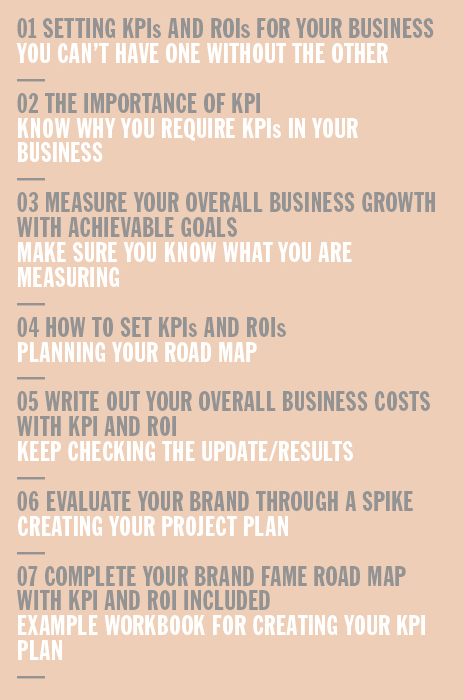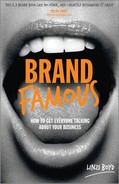CHAPTER 13:
STEP FIVE #EVALUATE
MEASURING YOUR SUCCESS AS A STAND-OUT BRAND
Congratulations on reaching the final step. You have put so much work into creating the ideas, producing the product, connecting it to retail and promoting it. So, how do you really know that all that hard work is paying off? Is there a way of actually “measuring success” so that it is not just guesswork or a wish and a prayer, but your brand is doing everything it is supposed to do? Why is it important to evaluate anyway?
You and I both know that this is the section that everybody dreads. I'd rather eat my own shoes, but over the years I have come to learn just how important it is and a part of me even leaps for joy when I have the figures laid out in front of me showing the results and achievements for all the efforts made. So if, like me, you would perhaps rather watch paint dry, let me at least help you through the evaluation process to ensure that the steps you are taking with your brand are going to:
- be beneficial for the brand,
- monetize the brand,
- and raise the profile of your brand.
Not evaluating your brand's progress is a little bit like working hard for an exam, then not bothering to find out the result. When I started Surgery all those years ago I didn't understand the evaluation process; I had to look up ROI and KPI to see what they stood for. None of the companies that I had worked with, large or small, had ever emphasized this in those early days of business when we worked on putting their marketing and PR plans together. Thirteen years on, we provide a service where we have to deliver return on investment and key performance indicators for every piece of work that we do. In fact, we wouldn't be doing a responsible job for our clients if we did not have both of these markers in place. This applies to both the client and your own business as well.
ENTER INTO THE … EVALUATE PHASE
My intention in this chapter is for you to see clearly why evaluating your brand is such an integral part of your brand journey. Without this piece of the pie, you will never know how close to or far from success you truly are. You might as well stick your finger in the air and fly by the seat of your pants. To be in a position to evaluate your brand, you will have to think about setting ROI and KPI targets in order to see if the projects you have delivered on have indeed been successful.
Over the years many people have mentioned that they find it hard to measure their success and deliver on expectations. Without a KPI in place it is impossible to know specifically what those expectations are and what somebody else in the business might perceive as a good or bad result. Imagine how different this could be if targets, budgets and goals are clearly defined at the beginning of each project and monitored throughout the project to ensure things are on track. Success is not only measured but also rewarded at the end of the project, when all expectations have been delivered upon. If I were to ask you to assess the different projects you are currently working on, would you know how well you are doing and what results you have actually achieved over the last year?
Setting targets and determining the return on your investments enables you and your team to deliver on projects and gauge their success. It's important to assess when things haven't worked and most importantly be able to investigate why so you can make the key changes that enable evolution and growth to take place within the brand. KPIs put in place reference points that enable you to compare one month with the next and, year on year, to check in and notice whether you are on track with your business plan and the projects you have laid out.
ROI is key to gauging whether the efforts poured into a project have reaped rewards. It enables you to look at the different aspects of the brands from brand awareness and data capture to the financial rewards which enable the brand to move on to the next phase of growth. Without knowledge of your ROI, how can you know how much money to invest in a particular area of your business?
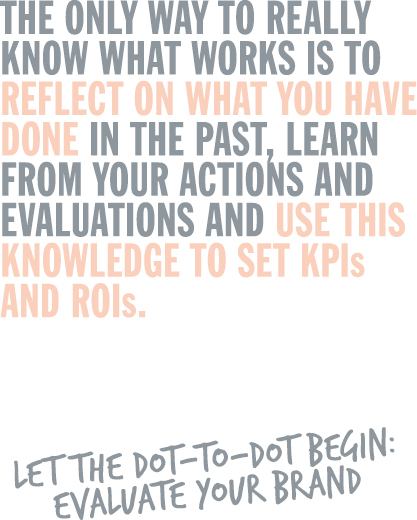
PLAY THE EVALUATE DOT-TO-DOT GAME
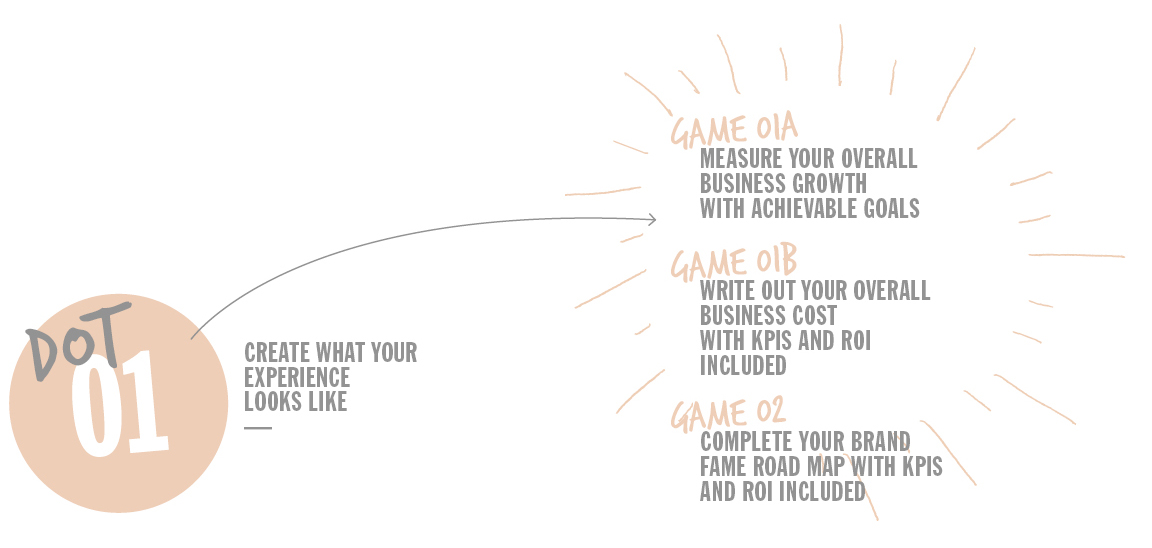
DOT 01 #EVALUATE
SETTING KPIs AND ROIs FOR YOUR BUSINESS – YOU CAN'T HAVE ONE WITHOUT THE OTHER
There are still many businesses setting KPIs and throwing hundreds of thousands of pounds at projects with no real awareness of what ROI they are looking to achieve. I find this alarming. Please don't be one of those businesses …
To reap the benefits of working to KPI with ROI, it's important to start today so you can instantly measure your results and know where, when and how to spend money on your business so that it is quantifiable and no longer about guesswork.
THE IMPORTANCE OF ROI
Creating the ROI for your whole plan reflects the budget that you have set aside to spend on the projects that you want to implement. I know that this can be a daunting process if you are in the build phase, for instance, unclear on how much spare money you may have, never mind what return on investment you think it will generate. Again, using the baby steps approach rather than no steps may be just what you need to get started.
This next comment could come as a shock. Ever since owning my first company, my personal mantra has always been “Don't allow money to stop you from doing anything” – I have to say it has always served me well. You might not have any money to spend on your dream project. So what? Your investment could be small but at least make sure that you know the possible return on that investment; if it's larger than what you put in then go for it. The goal is knowing what return you can realistically make and sensibly deciding how much you are willing to invest. Some companies invest millions. Do you think they would do that if they could not physically see a potential, possibly enormous, return on that investment?
Setting ROI enables you to have the confidence to spend money on projects that you may otherwise have avoided because you thought you lacked the money to spend in that area. In my experience it's not about lack of money, it's about knowing whether the money you put down on a project will come back in droves. That is not to say you can sit back and not do anything, your intention has to be there as if you had the money (create it, fake it …): the plan, the reason for doing it and the results that it will yield. The clearer you are, the less likely you will be to use money as an obstacle to stop you from doing something. You are now driving the vision to help the money find you more easily and quickly than it would have done before.
Whatever your stage of business – BUILD, RENOVATE OR REFRESH – there are certain things that you will be required to have in place:
- Something to sell is the first thing (e.g., a product or service).
- Someone to sell it to (a distribution channel).
- Marketing and PR to drive sales.
When working out the ROI for your projects, I would highly recommend that you take these three things into account, as without these it will prove very difficult to get going. If you have no idea how much money you have, or if indeed you don't have any money at all, then map out the dream scenario for getting your projects off the ground. Look at the most cost-effective way of making this happen so that you get it done to the best of your ability and do not compromise on look, quality or function.
Oddly enough, having worked with some of the biggest high-street brand names, they more often than not have come to the agency with next to no money to invest – and I sometimes mean £500 – to get a project off the ground. Being creative and having the drive to succeed are perfect ingredients to work out the projects that are going to give you the biggest return on your investment. You are also looking for an increase in your brand awareness, traffic driven through your distribution channel and loads of sales of your product so as to provide you with an income stream to work on the next product, service or project.
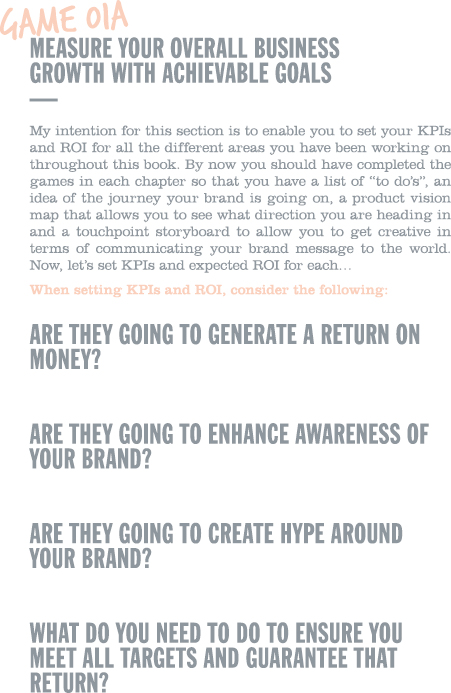
There will always be one or two things in each section that resonate with you, that you want to implement immediately. It is these things that we need to set KPIs for and work out your intended ROI. Below you will find a brand fame road map that showcases how this can be developed into phases of a critical path so that you can see how your own brand journey may take shape. Developing this enables you to be very specific about what you want to achieve at each step, allowing you to see growth in your business with results attached to success.
You must be clear about what you want to achieve from each step. You can set targets at three months, six months, nine months and one year (which can also be looked at as phases 1, 2, 3 and 4 for instance).
Before getting started
Take into account that the initial discover section is the area that I call “investing in your brand”. It is the stage where you are laying the foundations so that you can build a sturdy house. It will not bring a return in monetary terms, yet it will bring the biggest intangible return of all the five step chapters as you have set the blueprint and foundations for your brand. If you are in the build phase it is the essential area to understand your brand and if you are in the renovate or refresh stage it enables you to reconnect with your brand and see what, where and how you want to position yourself moving forwards.
Setting your overall KPIs and ROI for the brand
The first requirement is to have an idea of your budget and how you will use it to get the biggest return possible so that you can generate your future income stream, which will enable you to work on the next stage of your project.
Imagine having four different areas of the business, which are priorities for achieving results in the coming six months. By mapping these out, your projection could show that they will generate an income to allow three more areas to develop in the second half of the year using the profit you will have achieved from the first four.
Here is a reminder of what you could pull out from the different steps of the #brandfamous process that you may wish to draw on when putting your own map together:
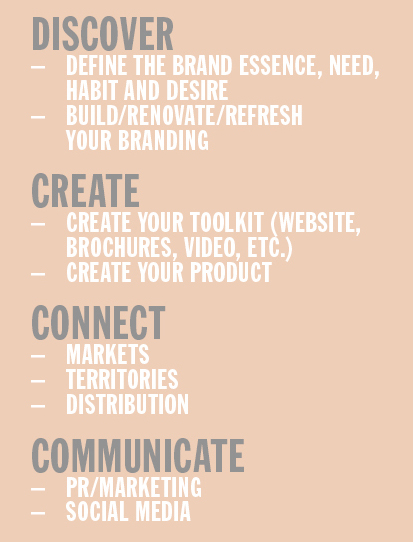
For each of these sections, create a document and think about what your targets are for the next year. You should aim to formulate the following:
- What it is you want to achieve.
- When it should be completed by.
- How you are going to action it.
- Who is going to work on it to make it happen.
A costing sheet will then provide you with clarity on what your budget is and how the project can generate a return on your investment.
HOW TO SET KPIS AND ROI
In order for you to really understand how to use this process, I have provided you with an example of a business costing that has both KPIs and ROI attached to it so that you can see the process and be able to replicate it.
The following business costing is based on a brand that runs an offline education programme selling courses. It is interested in a second phase of teaching online, along with selling own products and white label products. The brand was eager to move on by creating own product lines and realized the need to recoup some money first to be able to take the business to stage two. Below you will find the road map of where the business needed to go to enable growth for the business in phase 1.
PHASE 1 PLAN – ROAD MAP
Discover, create, connect and communicate

The process I have mapped out is very much a sales and marketing drive, showing how to move into phases 2, 3 and 4 to make up the overall plan for the year. It can be drawn up for the purposes of your brand to show against investment in:
- The brand
- Product
- A campaign
- All three combined
In order to achieve this first stage of growth, a brand needs to look at the targets that are being set, the initial investment to achieve these targets and the return on investment to enable the brand to move on to phase 2.
- 01 KPIs – the targets set to achieve a return on the investment made.
- 02 Investment for development – expenditure and fixed costs.
- 03 ROI – The actual return that comes from setting the KPIs and the money left over.
In order to know how to set the budget for phase 1 growth in the business, a brand needs to set their targets to see what areas they should be spending their money on to achieve a return on their investment. This should also enable them to evaluate phase 1 and the areas that were successful in order to then build upon them for phase 2 growth.
The return on investment for this was strong and proven in a number of different areas.
ROI for phase 1
- The assets are now in place to be able to drive more sales from the site onto the course and product lines.
- There is potential to sell higher-level courses to those people that came on the first course.
- A profit was shown even after all the setup costs had been put in place for the brand.
- Testing of white label product sold well, with further areas of growth after this period.
Going through this exercise in phase 1 enabled the brand to assess the first stage of growth and set the milestones for growth in the second phase of business development.

When working out your ROI, always consider the return you want to get from the project as well as the outcome that will best deliver on your quest for brand fame. Are you creating an e-commerce site to sell product along with a TV channel to showcase video content to raise awareness of the brand and drive traffic to the site and the services that you offer? Alternatively, are you using a website as a platform for case studies of work, with testimonials and updated video content, which you can manage and where you can highlight your work – updated on a regular basis – to generate interest and ultimately business from your YouTube channel with fresh new content.
Keep checking your progress
Once the projects are up and running, you will need to analyse if you are hitting your targets. Are you over or under the targets you set and how does this affect your ROI? Also, try to make sure that you stay out of the red and in the black with the costs that you have incurred. If one of your objectives was to create awareness and get new business from the website, what exactly has been the outcome and how much money has this generated in new business leads that have turned into transactions?
Assessment – end of each phase
The objectives you set at the beginning of each phase will give you clear guidance on whether you are hitting your targets and what areas you need to look at improving to enable sustainable growth. You should be able to assess via your online platform what has been the uptake from, for example, word of mouth and what percentage came directly from your marketing and social media campaigns or website. You should then be able to determine the exact return on your investment.
You can do this by looking at the amount of money you have spent on your project or website and relate it to the amount of sales that have come through the website/distribution channel. Also, assess through your online and print coverage what awareness and traffic have been brought to the brand. In this way something you initially thought was expensive could in fact become incredibly accessible in comparison when you see the benefits it has brought to your business.
Next time you look to update the site you will have a measurable result to base this on, so that you will know what percentage of money to spend in this particular area. If, in contrast, the project has generated neither income nor awareness (i.e. no ROI at all) then you will know that the project has not worked and you need to re-evaluate the site to see what changes can be made so that you do get the ROI that you are looking for next time around.
Once you have determined your overall plan with your KPIs set you must remember to update the targets on a monthly basis and make sure you stay on track.
Setting your budget
It does not matter how much budget you have, as any one of the projects could feed the others. If you have £5000 set aside you may want to use this to create your website, a promotional video and sample product line to sell on the site along with some creative thinking to promote your product and website (as listed in the communication section).
EVALUATE YOUR BRAND THROUGH A SPIKE
Now you have taken a good look at your overall plan, let's look at what happens when it comes to evaluating the launch of a special project or a limited edition range. Creating two plans – the one above and this one – will enable you to be flexible and creative with your execution of a project or a spike (as mentioned in the communicate section; touchpoint 5) so that the plan is developed as and when it is needed depending on what/when you are about to launch. This is much more flexible and can be dropped in at any time throughout the year as long as your budget permits
In the plan for your brand laid out above, you are able to work on fixed costs and targets that are there to create growth in your business year on year – tangible costs which create a platform to execute ideas and product that is moving with your business dependent on what is happening at the time. A creative project or something that is limited edition or short term is there to spike your brand awareness within the marketplace and create a platform to achieve stand-out status away from the normal execution of most business.
Creating your project KPI
Variable plan
- The five Ps:
- Promotional material
- Projects that are changeable on a seasonal basis
- Pop-up stores
- Products or services (limited edition)
- Partnership collaborations
When writing your plan for a creative concept, look at the five Ps to help you engage with your consumer and speak to them in the most creative way that is relevant to your core values. Looking at the five Ps will enable you to inject life into your business and give it a point of difference that will create the awareness that you desire to move away from the fixed costs that you are used to. Your cash flow projection will require these costs to be included in the overall plan with a cost structure defined so that you are able to get creative and look at how the ROI will be achieved from these projects. Bear in mind that one of these creative concepts may be the thing that escalates your brand to stand-out status; however, the fixed cost strategy is the thing that ties everything together so that you have a solid platform for your business to grow from. You cannot have one without the other and both provide the ROI that you require to have spikes and growth within your business.
The project KPIs are always set on the basis of launching something new in a creative way.

External KPI: How an external project can validate success
I mentioned that we work on the same process for our clients as we do for our own business – working with over 30 businesses at one time we set a strategy with measurable results so that both the agency and the client can set targets to achieve their long-term plan and evaluate year on year a growth pattern within their business. We have to write set targets for external businesses that we work with. You need to see which category your client sits in and work project by project, or maybe your business structure is set up so that you can write a standard plan which can be reworked on a six-monthly basis by just revisiting the set targets and not recreating new ideas.
Whatever happens, I suggest that you have measurable targets for everyone that you work with so that you are both clear on where you started and where you have arrived at in the working period together. It is great to then be able to measure your success and track the highs and lows so that you can revisit the circumstances for success and failure and monitor the situation. This also provides both parties with a reference so that when a new team starts to work on the account they have full understanding of where the client has been and what has taken place. Remember, where there is a will, there is a way – just take that step; life has a funny way of providing you with the things that you need most to make any project happen.
EXAMPLE WORK BOOK FOR CREATING YOUR KPI PLAN
Toolkit creation
Getting started – create a new toolkit:
- Website, videos, brochure.
- Look at your branding and see if it needs updating.
Updating your toolkit
- Write out set targets that you will stick with to update your toolkit.
- Who will update the website on a daily/weekly/monthly basis?
PR/marketing
Getting started – create a list of places where you can promote your product/services:
- Write out a press release.
- Prepare a biography on yourself.
- Take a profile picture.
- Prepare e-shots for new product alerts that you want to send out.
Social media
- Create a Facebook, Twitter, Instagram, YouTube and Pinterest account.
- Update these on a daily/weekly basis.
- Write out a social media plan. You can write down all of the things that you would like to do in the next year/even three years and then work backwards so that it goes into a micro plan.
Territories
This looks at how many offices you have and within which territories. You may not be trading out of anywhere at the moment, or you could have one office in the UK. Opening up multiple offices in different territories may enable you to:
- Open up an office in your country.
- Open up an office in multiple countries.
- Create one or multiple new divisions.
Markets
Looking at which markets you sell in at the moment; you may only have one.
Product
Which products/services do you want to create? A building product, DVD box set, clothing range, etc. How can you track the product sales? This will reflect on your distribution channel through online and in-store activity.
Distribution
- What distribution channels are you looking at?
- Create an amount every six months that you can track and monitor. The toolkit creation will play a part in evaluating the ROI so that you can monitor if this has created an awareness around selling in your product.
Winning new business
- Setting budgets.
- Getting creative with your toolkit.
QUICK PEEK CHEAT SHEET
WHAT WE HAVE EVALUATED
